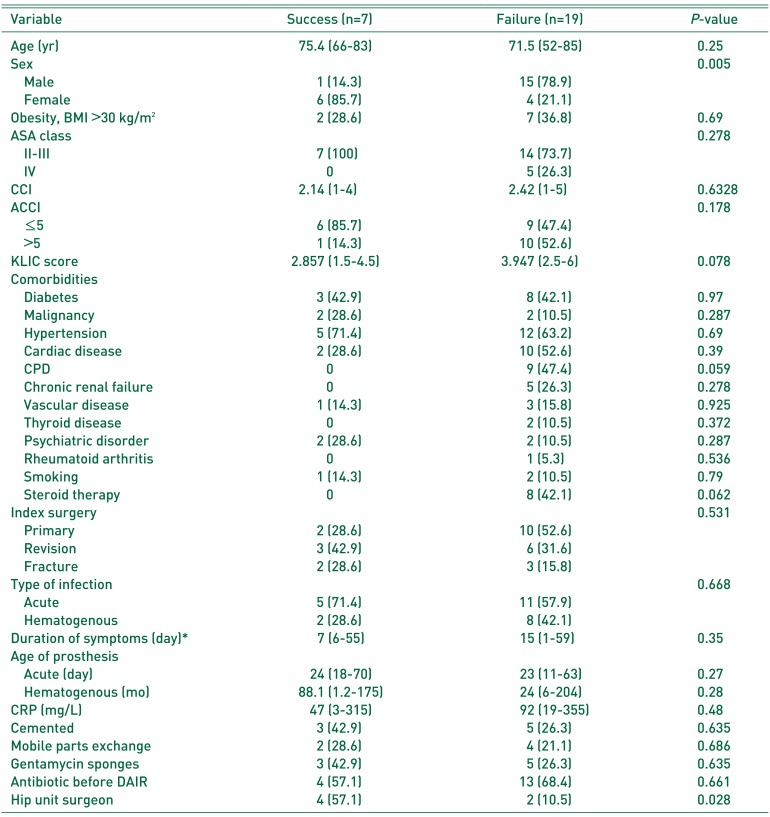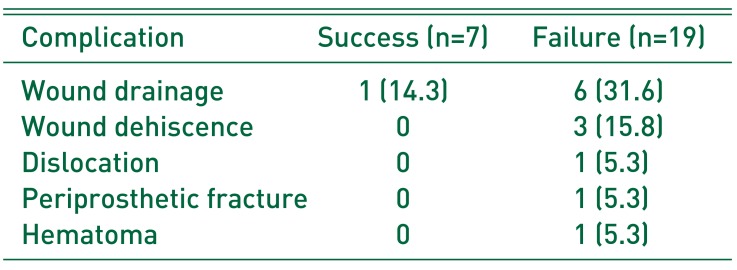1. Pulido L, Ghanem E, Joshi A, Purtill JJ, Parvizi J. Periprosthetic joint infection: the incidence, timing, and predisposing factors. Clin Orthop Relat Res. 2008; 466:1710–1715. PMID:
18421542.

2. Del Pozo JL, Patel R. Clinical practice Infection associated with prosthetic joints. N Engl J Med. 2009; 361:787–794. PMID:
19692690.
3. Dale H, Fenstad AM, Hallan G, et al. Increasing risk of prosthetic joint infection after total hip arthroplasty. Acta Orthop. 2012; 83:449–458. PMID:
23083433.

4. Bozic KJ, Ries MD. The impact of infection after total hip arthroplasty on hospital and surgeon resource utilization. J Bone Joint Surg Am. 2005; 87:1746–1751. PMID:
16085614.

5. Azzam KA, Seeley M, Ghanem E, Austin MS, Purtill JJ, Parvizi J. Irrigation and debridement in the management of prosthetic joint infection: traditional indications revisited. J Arthroplasty. 2010; 25:1022–1027. PMID:
20378306.

6. Achermann Y, Stasch P, Preiss S, Lucke K, Vogt M. Characteristics and treatment outcomes of 69 cases with early prosthetic joint infections of the hip and knee. Infection. 2014; 42:511–519. PMID:
24474624.

7. Fehring TK, Odum SM, Berend KR, et al. Failure of irrigation and débridement for early postoperative periprosthetic infection. Clin Orthop Relat Res. 2013; 471:250–257. PMID:
22552768.

8. Fink B, Schuster P, Schwenninger C, Frommelt L, Oremek D. A standardized regimen for the treatment of acute postoperative infections and acute hematogenous infections associated with hip and knee arthroplasties. J Arthroplasty. 2017; 32:1255–1261. PMID:
27839958.

9. Koyonos L, Zmistowski B, Della Valle CJ, Parvizi J. Infection control rate of irrigation and débridement for periprosthetic joint infection. Clin Orthop Relat Res. 2011; 469:3043–3048. PMID:
21553171.

10. Marculescu CE, Berbari EF, Hanssen AD, et al. Outcome of prosthetic joint infections treated with debridement and retention of components. Clin Infect Dis. 2006; 42:471–478. PMID:
16421790.

11. Crockarell JR, Hanssen AD, Osmon DR, Morrey BF. Treatment of infection with débridement and retention of the components following hip arthroplasty. J Bone Joint Surg Am. 1998; 80:1306–1313. PMID:
9759815.

12. Grammatopoulos G, Bolduc ME, Atkins BL, et al. Functional outcome of debridement, antibiotics and implant retention in periprosthetic joint infection involving the hip: a case-control study. Bone Joint J. 2017; 99:614–622. PMID:
28455470.
13. Klouche S, Lhotellier L, Mamoudy P. Infected total hip arthroplasty treated by an irrigation-debridement/component retention protocol A prospective study in a 12-case series with minimum 2 years' follow-up. Orthop Traumatol Surg Res. 2011; 97:134–138. PMID:
21388905.
14. Sukeik M, Patel S, Haddad FS. Aggressive early débridement for treatment of acutely infected cemented total hip arthroplasty. Clin Orthop Relat Res. 2012; 470:3164–3170. PMID:
22826016.

15. Triantafyllopoulos GK, Poultsides LA, Sakellariou VI, et al. Irrigation and debridement for periprosthetic infections of the hip and factors determining outcome. Int Orthop. 2015; 39:1203–1209. PMID:
25820839.

16. Tsukayama DT, Estrada R, Gustilo RB. Infection after total hip arthroplasty. A study of the treatment of one hundred and six infections. J Bone Joint Surg Am. 1996; 78:512–523. PMID:
8609130.

17. Westberg M, Grøgaard B, Snorrason F. Early prosthetic joint infections treated with debridement and implant retention: 38 primary hip arthroplasties prospectively recorded and followed for median 4 years. Acta Orthop. 2012; 83:227–232. PMID:
22489892.
18. Sendi P, Lötscher PO, Kessler B, Graber P, Zimmerli W, Clauss M. Debridement and implant retention in the management of hip periprosthetic joint infection: outcomes following guided and rapid treatment at a single centre. Bone Joint J. 2017; 99:330–336. PMID:
28249972.
19. Betz M, Abrassart S, Vaudaux P, et al. Increased risk of joint failure in hip prostheses infected with Staphylococcus aureus treated with debridement, antibiotics and implant retention compared to Streptococcus. Int Orthop. 2015; 39:397–401. PMID:
25183296.

20. Byren I, Bejon P, Atkins BL, et al. One hundred and twelve infected arthroplasties treated with ‘DAIR’ (debridement, antibiotics and implant retention): antibiotic duration and outcome. J Antimicrob Chemother. 2009; 63:1264–1271. PMID:
19336454.

21. Parvizi J, Zmistowski B, Berbari EF, et al. New definition for periprosthetic joint infection: from the Workgroup of the Musculoskeletal Infection Society. Clin Orthop Relat Res. 2011; 469:2992–2994. PMID:
21938532.

22. Charlson ME, Pompei P, Ales KL, MacKenzie CR. A new method of classifying prognostic comorbidity in longitudinal studies: development and validation. J Chronic Dis. 1987; 40:373–383. PMID:
3558716.

23. Charlson M, Szatrowski TP, Peterson J, Gold J. Validation of a combined comorbidity index. J Clin Epidemiol. 1994; 47:1245–1251. PMID:
7722560.

24. Tornero E, Morata L, Martínez-Pastor JC, et al. KLIC-score for predicting early failure in prosthetic joint infections treated with debridement, implant retention and antibiotics. Clin Microbiol Infect. 2015; 21:786.e9–786.e17.

25. Manley M, Ong K, Lau E, Kurtz SM. Effect of volume on total hip arthroplasty revision rates in the United States Medicare population. J Bone Joint Surg Am. 2008; 90:2446–2451. PMID:
18978414.

26. DeLee JG, Charnley J. Radiological demarcation of cemented sockets in total hip replacement. Clin Orthop Relat Res. 1976; (121):20–32. PMID:
991504.

27. Gruen TA, McNeice GM, Amstutz HC. “Modes of failure” of cemented stem-type femoral components: a radiographic analysis of loosening. Clin Orthop Relat Res. 1979; (141):17–27.
28. Aboltins C, Dowsey MM, Peel T, et al. Early prosthetic hip joint infection treated with debridement, prosthesis retention and biofilm-active antibiotics: functional outcomes, quality of life and complications. Intern Med J. 2013; 43:810–815. PMID:
23656615.

29. Bergkvist M, Mukka SS, Johansson L, et al. Debridement, antibiotics and implant retention in early periprosthetic joint infection. Hip Int. 2016; 26:138–143. PMID:
26868114.

30. Zmistowski BM, Manrique J, Patel R, Chen AF. Recurrent periprosthetic joint infection after irrigation and debridement with component retention is most often due to identical organisms. J Arthroplasty. 2016; 31(9 Suppl):148–151. PMID:
27378647.







 PDF
PDF ePub
ePub Citation
Citation Print
Print





 XML Download
XML Download